dwell on design discussion looks beyond water savings to LA’s resilience
July 21, 2016. Cassy Aoyagi: LA has taken action to address the drought and produced measureable water savings, but have these actions put us on a path to resilience?
I had the incredible pleasure of moderating a conversation between some of LA’s top urban environment and green building experts at Dwell on Design this year. Travis Longcore of the University of Southern California, Global Green’s Walker Wells, and John Zinner of Zinner Consultants, shared their perspectives on LA’s shifting landscape standards.
Here are some highlights from our conversation.
Are gravelscapes and synthetic lawns the emerging standard?
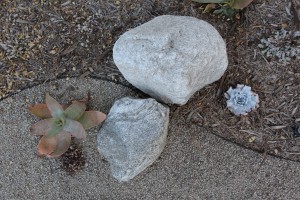 Travis Longcore: The pendulum has swung too far – gravel should be frowned upon. We have lost the majority of our permeable spaces in the last decade.
Travis Longcore: The pendulum has swung too far – gravel should be frowned upon. We have lost the majority of our permeable spaces in the last decade.
Landscapes that divert stormwater to support trees and bushes are more sustainable. Trees, specifically, are worth every penny and drop – they protect property values and cool cities.
John Zinner: Andy Lipkis, TreePeople founder, has noted that, before Europeans arrived, 3 percent of LA’s rainfall drained to the ocean. Now it’s over 65 percent.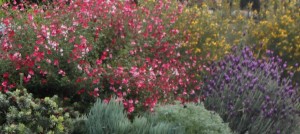
We spend billions pushing rain to the ocean as fast as possible then spend billions to import water from hundreds of miles away. It doesn’t make sense.
Walker Wells: We need to appreciate a new aesthetic- not a desert one – an aesthetic appropriate to our Mediterranean climate.
We also need to look at the totality of what we are creating. Gravel has desiccated the land, so there isn’t the moisture to support trees. Just as we measure water use, we should be measuring the heat a landscape creates.
If gravelscapes go too far, how can LA save water and protect overall resilience?
 Travis Longcore: Each property can be a water management system simply by minimizing hardscapes and capturing water from as many spaces as possible – roofs, drives, patios. Our planted spaces could support many more trees as a result.
Travis Longcore: Each property can be a water management system simply by minimizing hardscapes and capturing water from as many spaces as possible – roofs, drives, patios. Our planted spaces could support many more trees as a result.
John Zinner: We need to help people understand the big picture. Bathroom fixture water efficiency has been pushed about as far as it can go. Irrigation efficiency-landscapes-hold the most promise for continued water savings.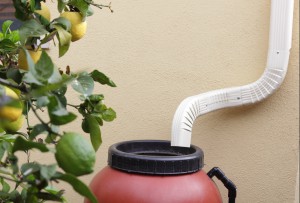
We also need to be sure people know that while synthetics, at least in people’s yards, save water they have other, negative consequences. They hurt the soil beneath them. They’re hot-they create heat islands. LAUSD has to water synthetic playing fields to cool them so kids can play.
Walker Wells: Climate compatible, not “drought tolerant” should be the measure for foliage. We need to think beyond water to biodiversity, etc.
We also need to watch what we measure. We should look at the rates at which water permeates the soil [instead of only water application]. By measuring only the water that goes into a landscape, we are encouraging landscapes that harden soils and create runoff.
How do we encourage a standard goes beyond water-wise to resilient?
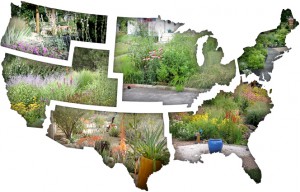 Travis Longcore: We had a USC project that asked students to create an awareness campaign about what a climate-compatible landscape looks like. Part of the problem is that people just don’t understand what to do.
Travis Longcore: We had a USC project that asked students to create an awareness campaign about what a climate-compatible landscape looks like. Part of the problem is that people just don’t understand what to do.
Walker Wells: Part of the equation is what people are taught to desire. We’ve been trained to see an east coast or Midwest landscape as a more prestigious look. Now we want simple, we value quality.
John Zinner: People’s [aesthetic] preferences can change, but changing market preferences takes time. Sometimes it is codes, sometimes it is funders who can change behavior. My hope is that sometime soon synthetic turf will look so strange people will feel compelled to take it out.
How do we encourage a more optimally sustainable standard?
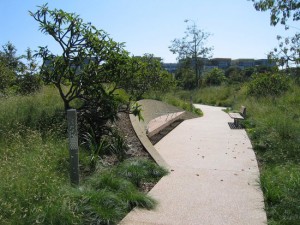 Walker Wells: Public spaces should bridge the gap by setting new standards and helping people understand them. We have to stop seeing landscapes as the background and start noticing them and their impact. There is a big difference, for example, between the water use at the new Tongva Park in Santa Monica and the established courthouse lawn, but we don’t see it in the same way we see the buildings.
Walker Wells: Public spaces should bridge the gap by setting new standards and helping people understand them. We have to stop seeing landscapes as the background and start noticing them and their impact. There is a big difference, for example, between the water use at the new Tongva Park in Santa Monica and the established courthouse lawn, but we don’t see it in the same way we see the buildings.
John Zinner: Developers live and die by the budget. There needs to be a way to offset [initial] costs. CALGreen and LEED® have started to change practices. We need good codes that remove – or don’t create – barriers, encourage right action, and 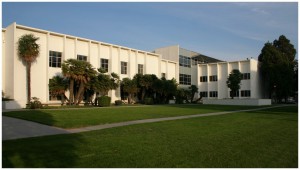 create mandates where the market fails.
create mandates where the market fails.
Travis Longcore: Landscape designers have to communicate – we will have a hotter, deader city if we allow [gravelscaping] to become the standard. We need to push as much water into our ecology as we can. Price has been a factor, but I believe people are willing to make investments that make their hearts sing.






